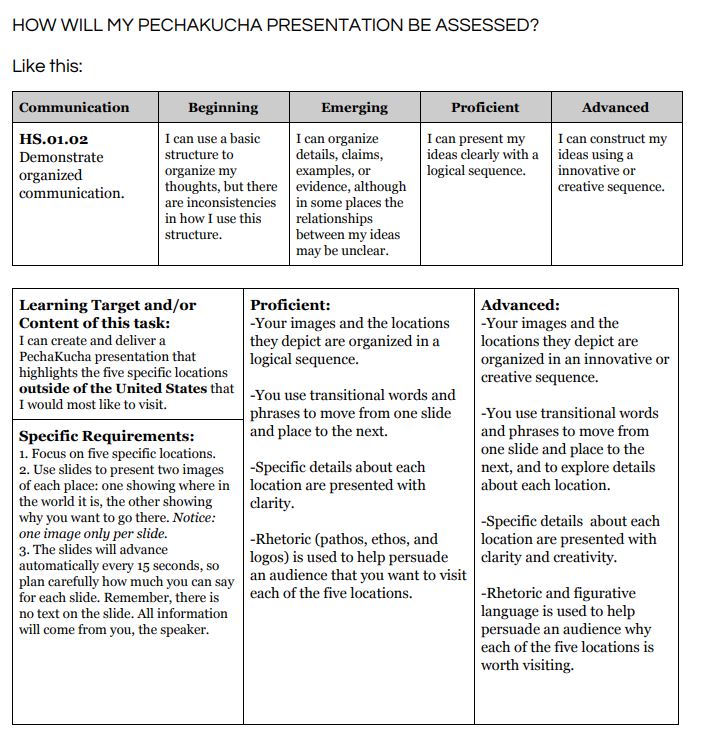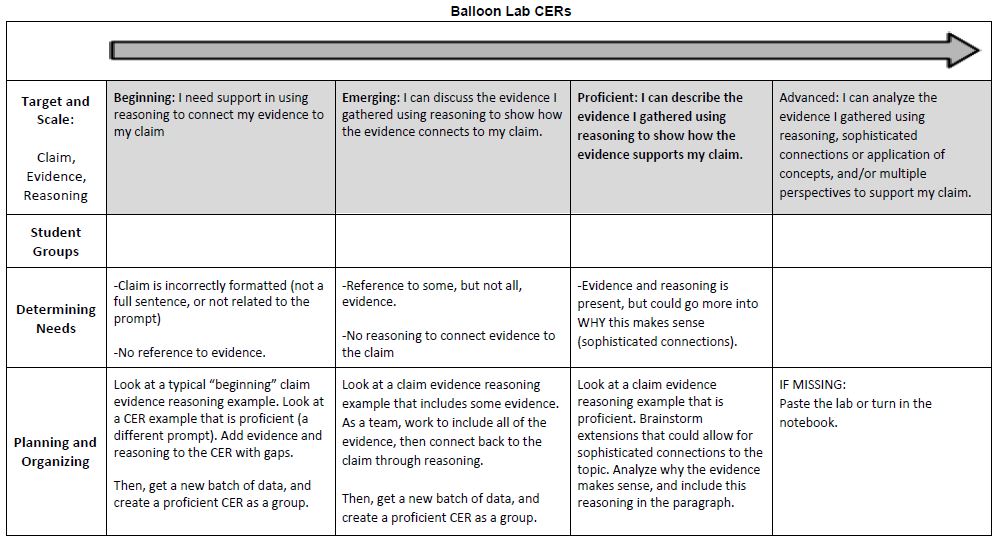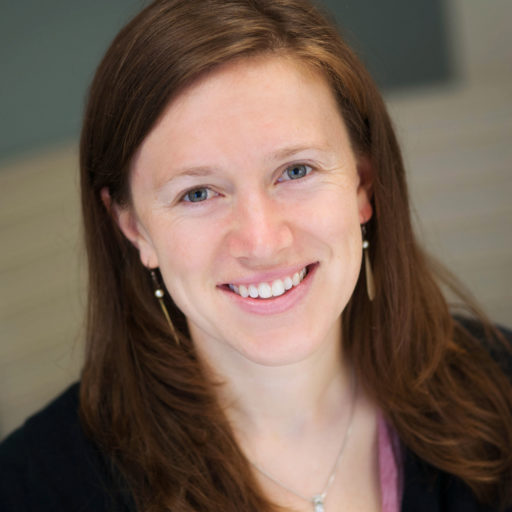In the 2016–2017 academic year, our school transitioned to a proficiency-based grading (PBG) system in accordance with a state law which required Vermont schools to create “Flexible Pathways” to graduation. Flexible Pathways are “high-quality expanded learning opportunities, including academic and experiential components, which build . . . proficiencies and lead to secondary school completion, civic engagement and postsecondary readiness” (Vermont Agency of Education, 2017). In PBG, the focus is on students demonstrating skills defined by a school, with the purpose of giving students and teachers a clearer view of the current strengths of student understanding and areas for growth.
With open-ended language from the state and a principal dedicated to helping all students make progress toward cross-curricular, measurable skills, our school set out to design a new system of teaching and graduating students. In this article, we describe the impact that this shift to PBG has had on our teaching practice, as well as the role that collaborative structures played in implementing a new grading system.
At our rural Vermont middle and high school of roughly 500 students, Jonah teaches the English component of a ninth grade English/history class called Global Studies and Carly teaches ninth grade Earth and space science. Because our school’s shift to PBG started with ninth grade and moved to higher grades in successive years, our ninth-grade team of teachers with common students was among the first to use the model.
In our classrooms, we focus on skills that we select from a school-wide master list divided into 10 general categories: communication, creative expression, global citizenship, inquiry, integrative thinking, problem solving, reading, writing, wellness, and self direction. For example, in Earth and space science, one of our focuses is on the skill of using “evidence and reasoning to justify claims,” which falls under the broader proficiency of integrative thinking (Figure 1). Students have multiple opportunities throughout the year to show evidence of this skill and build on it through practice and feedback tied to school-wide rubrics.

Figure 1. An example of specific skills (blue) that make up a “proficiency” (red). Courtesy of Harwood Unified Union School District.
Shifts in Teaching Practice
While we are designing and revising our proficiency-based system school-wide, we realize that some of the most impactful changes are made at the classroom level, both in curriculum and how teachers engage with students. In using this new type of feedback and grading system, we have come to see how important it is to build relevance for students as we shift from content to skills-based teaching.
It takes creativity to imagine engaging ways for students to work together to take on real challenges and solve real problems, as well as to tap into students’ inherent curiosity to help drive the development of their skills.
It is imperative that we help students understand that the skills they are developing in our classrooms will be useful to them in the future, even when—perhaps especially when—we can’t foresee how. Helping students recognize and build these skills has resulted in shifts in our teaching practice that provide relevance for our students and specific feedback that celebrates and grows their skills. We highlight three shifts within our classrooms below.
Shift 1: An Intentional Focus on Skills (Jonah)
My history teaching partner and I recently found ourselves with an interesting problem. Our class is focused on global citizenship, culture, geography, literature, and current events. We had just finished a unit on revolutions and, with two weeks until vacation, didn’t want to launch something new only to be interrupted. We selected two key skills we wanted students to work on: creating and delivering presentations and demonstrating organized communication.
After some serious brainstorming sessions squeezed in during lunches and after-school meetings, we discovered a way to let students use their own creativity and interests while practicing the skills we were looking to develop. The Bucket List World Tour PechaKucha Contest was born, giving students a chance to design a creative presentation showcasing the five places outside of the United States where they would most love to travel.
The PechaKucha is a presentation format created by two Japanese architects that features 20 slides advancing automatically every 20 seconds (“PechaKucha 20×20,” n.d.). Each slide contains a single image and no text, and the images illustrate the ideas conveyed by the presenter. The constraints of the assignment forced our students to think creatively, to organize their ideas logically, and to express themselves in a clear and concise way. Students researched locations around the world, looking for places as diverse as the best areas to see migratory birds in South America to the most gay-friendly cities in Asia.
Our implementation of proficiency-based teaching and grading has allowed us to be more flexible with our content, giving more choice to students and letting their interests drive what they are learning. This has pushed us to focus our attention on what is most essential: the skills students will be using in the future long after they have (perhaps) forgotten the content through which they practiced and developed these skills.
In this new approach, we always begin a project by showing students exactly what skills they will be practicing, what our expectations are, and how their work will be assessed. Using the rubric (Figure 2), students practiced their PechaKucha presentations in small groups, giving each other feedback on skills such as the use of emotion and rhetoric, gestures and eye contact, and transition words and phrases. The energy level and engagement was high, skills were developed, and we believe that we encouraged some future world travelers to follow their interests around the globe.

Figure 2. A rubric that students will be assessed with, as well as specific information for what “demonstrating organized communication” looks like for a specific task.
Shift 2: Organizing Formative Assessment Results (Carly)
In my classroom I use formative assessments to develop a better understanding of students’ needs on a specific skill, then offer targeted feedback and/or adjust my instruction in order to prepare my students for a summative assessment of their skills. One challenge I’ve faced was organizing formative assessment results and then deciding on concrete next steps to address the diverse student needs represented in those results.
We have been encouraged to use charts adapted from Champlain Valley Union High School (Williams & Rinkema, 2017) as a way to map student progress from a formative assessment and to better challenge students (Figure 3). Of course this mapping and feedback could have happened in a traditionally-graded classroom, but it wasn’t a practice in my classroom until I had the language developed through school-wide rubrics that allowed me to give specific feedback to my students.
In one task in my classroom, students use balloons to model changes within our universe as it expands. Students then developed a claim, evidence, reasoning paragraph (CER) based on their findings. As I formatively assessed students using the rubric, I also noted common areas of strengths and challenges for students who were at each of the four levels of the rubric.
We have come to see how important it is to build relevance for students as we shift from content to skills-based teaching.
From this, I developed three different activities to support students at their current level of understanding in writing a CER, each with the goal of helping teams of students reach proficiency at a minimum. For example, students who were marked as “beginning” were tasked with editing a sample claim to ensure it’s a full sentence, then rewriting a sample evidence statement to include specific data. Students whose work was identified as being “proficient” were tasked with helping a pseudo-student add sophisticated connections and extensions in their reasoning.
This process of designing new tasks to address targeted student needs, while time consuming, gave students a clear model of what to work towards when writing future CER paragraphs. Using the chart also allowed me to easily organize my next steps based on the formative assessment. The next time students were asked to do CER paragraphs, I noticed more students had fully developed claim statements to reference specific evidence.

Figure 3. A chart organizing formative assessment results for a lab in Earth and space science.
Shift 3: Reconsidering the Role of Tests and Quizzes (Carly)
One discussion in several departments has been how some traditional practices, like tests and quizzes, might still play an important role in our PBG school. In our science department, we have continued to assess students through quizzes and tests, in addition to more project-based assessments. Through extensive department discussion, we have agreed that, for now, we do still see value in this traditional practice, as students will be expected to take quizzes and tests in many contexts outside of school (e.g., driver’s permit tests, tests for certifications in various fields, college-level tests and quizzes, etc.) Furthermore, well-crafted quizzes allow students to practice working with the content in a different way, and can provide information about their content knowledge.
However, in my classroom, I have decreased the focus on this type of assessment. This is, in part, because I have designed my assessments to reflect the diversity of skills involved in project-based assessments, but is also because I’m still trying to work out where these traditional assessments best fit in our PBG model. Are quizzes treated as a separate “content gate” that students have to pass to move on? Do we assess students on skills within the quiz? Or is there a separate rubric that highlights the skills involved in preparing for or taking tests and quizzes? So far, the shift in my classroom has been to use quizzes as formative check-ins with students, but we are still in the process of finding their place in our classrooms.
The Importance of Collaborative Structures
Because of our developing focus on broader skills, students at our school can be assessed on the same skill in multiple classrooms. This overlap requires not only communication within and between departments, but also calibration of our understanding of what each level of a rubric looks like in student work as we assess the same skill across classrooms. Here we share two examples of how collaboration was necessary under this new system.
Collaboration 1: Calibrating a Communication Skill (Carly)
Our two ninth-grade teams have followed an inquiry protocol to make observations about our assessment of students in communication. The “proficient” level of clear and effective communication was described as “I can present my ideas coherently, with a logical sequence and use academic language and/or images to enhance my message and present my subject in a precise manner.”
We brought student work to the ninth-grade teams to generate conversation about this skill. Science teachers brought lab reports written by students after they designed and carried out an investigation, while global studies teachers shared student narratives of culture clashes resulting from personal interviews. Using these as data, we were able to have open conversations about what proficient looked like in this skill, and how to support and challenge students in this area.
Looking at the prompts and student work from other courses allowed me to see that we weren’t providing structures that many of our students needed in science in order to reach proficiency in communication. This prompted us to provide more specific guidelines and graphic organizers for students to better support them in moving toward proficiency as they write their lab reports.
Because of our developing focus on broader skills, students at our school can be assessed on the same skill in multiple classrooms.
This allowed students to more clearly communicate their ideas than our students had on the same project in previous years.
Collaboration 2: Using Student Work to Address Common Feedback (Jonah)
Feedback from colleagues has helped me to realize that I need to be doing a better job of isolating the skills that students are not yet fully grasping and directly showing students what work at different levels looks like to help them develop.
This year, we are assessing students in our large, co-taught, interdisciplinary class on the skill of using evidence to support a claim multiple times and in multiple different contexts. While reviewing student writing, I found myself making the same comment over and over again, highlighting a section of analysis and reminding students that they need to explain how their evidence explicitly supports and helps prove the idea in their claim. Despite the frequency with which I have left this comment for students, I have yet to notice many of them fully understanding and learning this skill.
Based on helpful and critical feedback from colleagues, I will be using examples of student work the next time I teach and assess this skill. Using a mini-lesson, I will show students different levels of analysis to illustrate the difference between connecting to a claim as opposed to fully supporting a claim. In this instance, the feedback of my colleagues during a ninth-grade meeting has directly led to a change (and hopefully an improvement) in my teaching practice.
Next steps
Though we have worked to develop a common understanding of what it means to be proficient in one aspect of communication, the nature of our PBG model is that many skills are commonly assessed across classrooms. This drives a need for us to be able to come to a shared understanding, through intentional collaboration, of what we are expecting from students and how we can help them develop a variety of skills.
One area of continued focus for us is developing structures within our classrooms and the school that best challenge students at their level and encourage them to continue to progress in their skills. This might look like offering more enrichment activities in which students can further develop their skills. For example, in the past, Jonah has offered an extracurricular reading group in which students voluntarily read complex texts and then discussed them as a group. We recognize the need for more such opportunities within our school. This might also look like a continued shift within our classes that allow students more choice or opportunities to show their skills.
We continue to pursue a model of education that meets each student where they are and helps them make progress in developing essential skills. In the back of our minds, however, is this great wondering: how can we help all students maximize learning and engagement at the same time?
Jonah Ibson teaches the English half of a co-taught humanities class and serves on the ninth-grade team with an amazing Knowles Teaching Fellow at Harwood Union High School in Moretown, Vermont. His previous experience at two different middle schools in rural Vermont helped him develop a passion for interdisciplinary teaching and an appreciation for high-functioning, educational teams. He has been a member of the leadership team at Harwood for three years, working to design and implement a proficiency-based system for teaching, learning, and assessment. Reach Jonah at jibson@wwsu.org.
Carly Brown, a 2014 Knowles Teaching Fellow, teaches Earth and space science as well as marine science at Harwood Union High School, where she serves on the ninth-grade team. She previously worked as the only high school science teacher at Craftsbury Academy and as a high school science teacher in Kenya. These experiences highlighted the importance of developing strong, collaborative networks in an education climate that is changing so quickly. Contact Carly at carly.brown@knowlesteachers.org.





